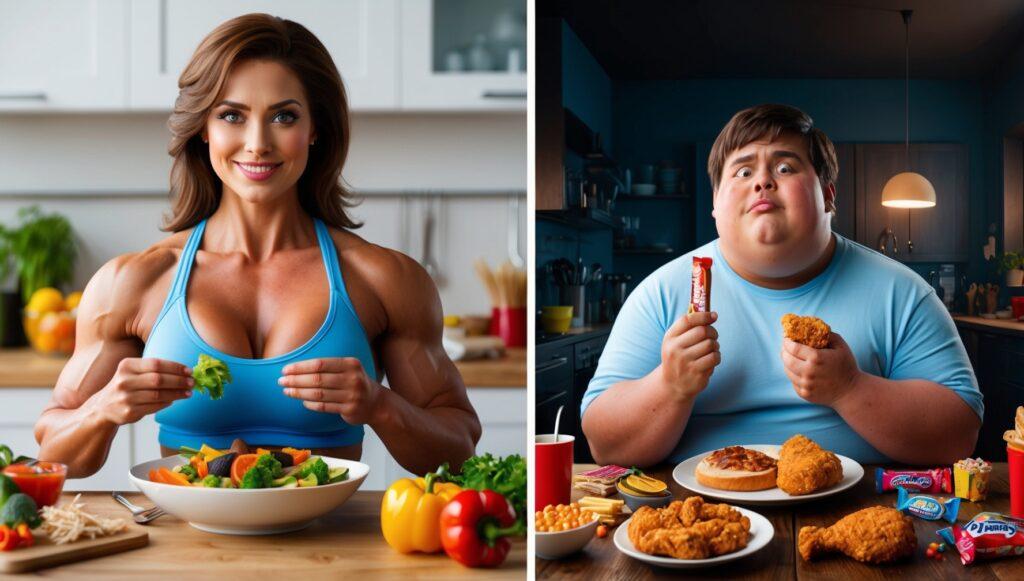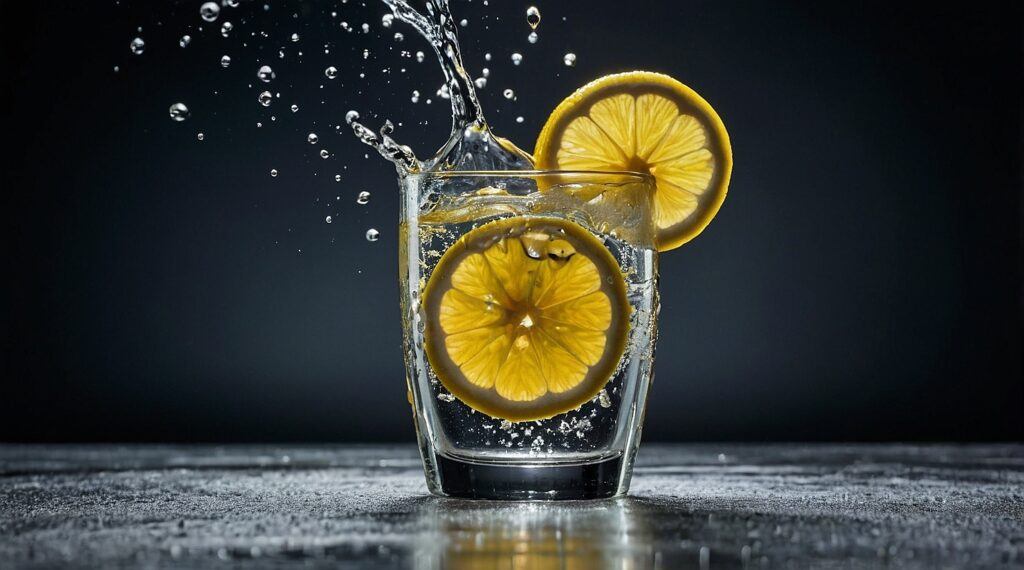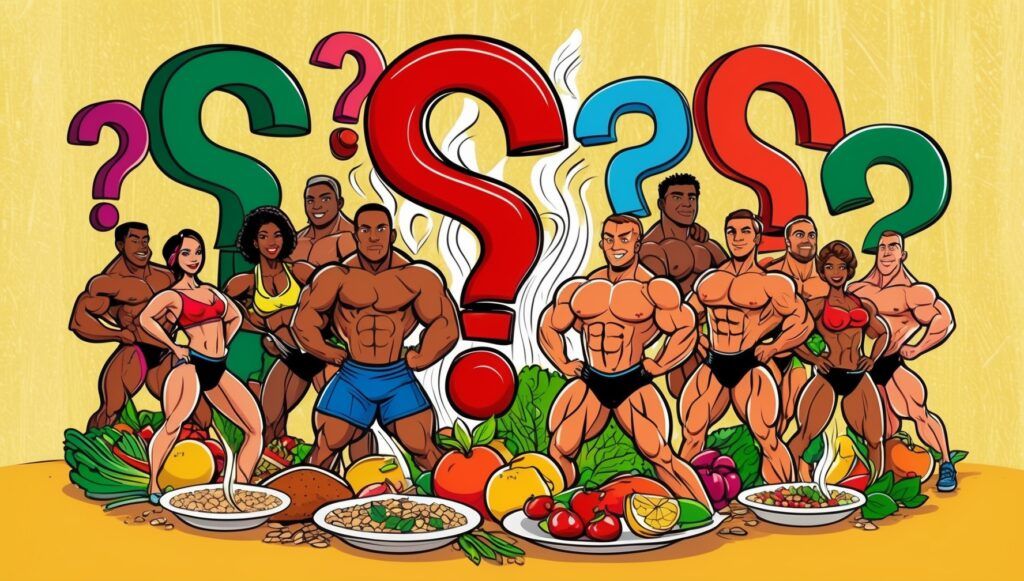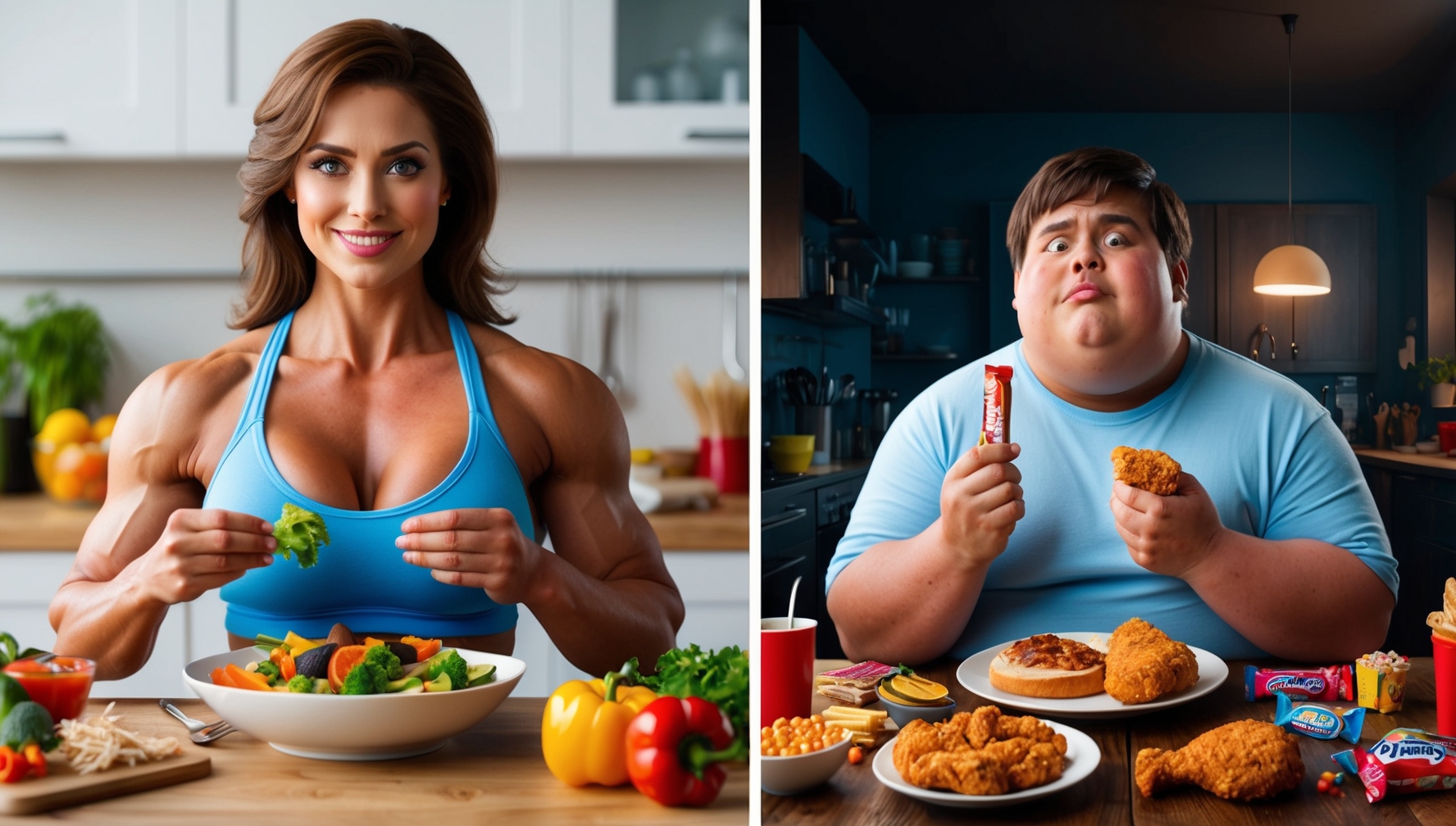By Dr. David Crowther, BDS, BPharm

Introduction
Welcome back to the Lean Gainz Equation series! If you’ve been following along, you know we’re breaking down the key components of optimizing muscle growth and fat management. Today, we’re diving into the Satiety Index (SI) part of the equation, which plays a crucial role in helping you manage your hunger and stay on track with your nutrition goals. It’s also the first of the modifying factors we’re discussing. The modifying factors allow you to comfortably minimize your caloric intake or maximize how many calories you burn each day. Of all these modifying factors, SI is probably the most important.
Let’s quickly recap the Lean Gainz Equation:
Energy Balance = CI – [BMR + AL + TEF] – [SI + PRA + MMF + PIF + EMF]
Here’s what those abbreviations stand for:
- CI: Caloric Intake
- BMR: Basal Metabolic Rate
- AL: Activity Level
- TEF: Thermic Effect of Food
- SI: Satiety Index
- PRA: Psychological and Routine Adherence
- MMF: Muscle Maintenance Factor
- PIF: Pharmacological Influence Factor
- EMF: Evolutionary Mismatch Factor
Now, let’s get into how understanding satiety and the Satiety Index can make your diet more effective and sustainable.
Dr. Gainz’s Early Understanding of Satiety
For as long as I can remember, I’ve known that some foods fill you up more than others. It’s not just about energy content—clearly, 1000 calories from a healthy meal with lots of green vegetables, lean meats, and rice is much more filling than the same amount of calories from a chocolate bar. Early on, I realized that the calorie density of food played a role in how filling it was, but it wasn’t the whole story. If it were, we could just drink lots of water and feel full. But as I learned, it’s not that simple. Liquid thickness, fiber content, and macronutrient composition all interact to influence how hungry we do, or don’t, feel.
The Science of Satiety: What Keeps You Feeling Full
When discussing satiety, it’s essential to understand the underlying mechanisms that signal to your brain that you’ve had enough to eat. While early on, I recognized that certain foods were more filling than others, my understanding deepened when I learned about the physiological processes involved.
Stretch Receptors in the Stomach
One of the primary mechanisms of satiety involves stretch receptors in the stomach. These receptors are triggered when the stomach expands as it fills with food. High-volume foods, such as vegetables and other water-rich options, activate these receptors more effectively, sending signals to the brain that you are full. This is why a large salad or a bowl of broth-based soup can make you feel more satiated than a small portion of calorie-dense foods.
However, it’s not just about the volume of food. The nature of the food—the macronutrient, fiber, and water content—also plays a crucial role in how long you stay full. If it were only about volume, simply drinking water or eating low-calorie fillers would suffice, but we know that’s not the case. Let’s explore how these factors contribute to satiety.
The Role of Macronutrients

The Role of Macronutrients in Satiety
Protein and Satiety Hormones
Protein plays a significant role in satiety due to its effect on hunger hormones. When you consume protein, it stimulates the release of hormones such as peptide YY (PYY) and glucagon-like peptide-1 (GLP-1). These hormones slow down gastric emptying, meaning food stays in your stomach longer, and they also reduce appetite by signaling fullness to the brain. This makes protein an essential component of any meal when your goal is to stay satisfied for longer periods.
Fats and Their Influence on Satiety
Fats contribute to satiety in several ways. Firstly, dietary fats slow down the digestive process, which can help prolong feelings of fullness. Fats also stimulate the release of cholecystokinin (CCK), a hormone that signals satiety to the brain. However, fats are calorie-dense, so while they are effective at promoting satiety, they must be consumed in moderation to avoid excessive caloric intake.
Additionally, fats are involved in the production of leptin, a hormone produced by fat cells that signals satiety to the brain. Low levels of body fat can reduce leptin production, leading to increased hunger and difficulty in maintaining energy balance.
Carbohydrates: The Complex and the Simple
Carbohydrates have a varied effect on satiety, depending on their type. Simple carbohydrates, particularly those high in sugar, can cause rapid spikes in insulin levels, which are often followed by a quick drop in blood glucose levels. This can lead to a cycle of hunger shortly after eating, making simple carbs less effective at promoting satiety.
In contrast, complex carbohydrates, especially those high in fiber, are digested more slowly. This slower digestion process helps maintain stable blood sugar levels, reducing the likelihood of insulin spikes and subsequent hunger. High-fiber foods also slow gastric emptying, prolonging the feeling of fullness.
The Importance of Fiber in Satiety

Fast forward to my 30s, and it finally clicked: fiber is a big deal when it comes to satiety. I wasn’t thrilled about eating fibrous foods, but I couldn’t ignore how filling they were. I even tried Metamucil, hoping it would help with weight loss, but real foods with fiber proved far more effective. It’s not just about bulk; fiber interacts with water in your body, creating that satisfying fullness. If I’d just listened to my mother’s advice about eating my vegetables, I might have been ahead of the game. But what did she know about getting ripped? Turns out, more than me. But hey, better late than never, right?
Fiber is a critical component of satiety for several reasons:
Bulk and Water Retention: Fiber adds bulk to the diet, which physically fills the stomach, activating stretch receptors and signaling fullness to the brain. Fiber also retains water, further increasing the volume of food in the stomach without adding calories.
Slowed Digestion: High-fiber foods slow down digestion, which prolongs the absorption of nutrients and extends the period during which you feel full. This is particularly important for managing hunger and maintaining a balanced energy intake.
Hydration—The Unsung Hero of Satiety

Water plays a significant role in satiety, yet it’s often forgotten in the discussion of diet and nutrition. Proper hydration helps regulate appetite and can prevent overeating. Sometimes, what we perceive as hunger is actually thirst. Drinking a glass of water before meals has been shown to increase feelings of fullness and reduce overall calorie intake.
I’ve always believed in drinking when thirsty rather than following the “8 glasses of water” rule, which I thought was BS. But I sometimes forget that thirst can be mistaken for hunger. Staying hydrated wouldn’t hurt—actually, it would likely help keep my diet on track. So next time you feel hungry, try reaching for a glass of water first. It might be just what your body really needs.
Citation: Stookey, J. D., Constant, F., Popkin, B. M., & Gardner, C. D. (2008). Drinking water is associated with weight loss in overweight dieting women independent of diet and activity. Obesity, 16(11), 2481-2488. https://doi.org/10.1038/oby.2008.409
The Impact of Sleep on Hunger and Satiety
Sleep is often overlooked when discussing diet and nutrition, but it’s a critical factor in regulating hunger and satiety. Poor sleep disrupts the balance of hunger hormones, namely leptin and ghrelin. Leptin, which signals satiety, decreases with sleep deprivation, while ghrelin, which stimulates hunger, increases. This hormonal imbalance can lead to heightened hunger and cravings, particularly for high-calorie, carbohydrate-rich foods.
Let me share a personal story. Many years ago, I was working two full-time jobs—one during the day and another at a casino until 3 a.m. The casino job was quite physical, but despite all that activity, I was still getting fat. How? By stuffing my face with junk food and fast food to keep going. I was so tired that I started seeing things and making stupid mistakes at both jobs. There was one time at the casino when I almost took a customer’s money instead of paying them out. Yeah, that didn’t make me too popular. Eventually, I pulled the plug on my night job. Once my sleep returned to normal, so did my diet. It took me years to realize that my poor sleep was driving me to eat like a maniac. The lesson here? If you’re not sleeping well, your appetite control goes out the window. So, if you want to master satiety, start by mastering your sleep.

Citation: Walker, M. P. (2019). Why We Sleep: Unlocking the Power of Sleep and Dreams. Scribner. This book delves into the effects of sleep on various aspects of health, including appetite regulation.
Psychological and Routine Adherence (PRA)
Let’s talk about the mind game. For me, routine is everything. When I have a set routine, it’s easy to control my eating. But when I let my routine slip, it’s not long before I notice my waistline expanding—a clear sign that sticking to a routine is crucial for staying on track. If I plan to have eggs for breakfast and end up eating Weet-Bix instead, I feel like I haven’t had my real breakfast, and before I know it, I’ve eaten both! Apps like FitnessPal aren’t just helpful—they’re practically essential for me. It’s taken me years to appreciate that a routine makes it easier to control my diet without feeling deprived. In fact, most of my life is improved by living by routines. It eliminates a lot of decision fatigue and makes eating well a lot easier. Routine makes my life easier in so many ways. I go to bed at the same time and get up at the same time, and this has improved my life much more than I ever thought it would. Sleep has an impact on satiety as I’ve already mentioned. When I’m not sleeping well and my life is disorganized, I find myself eating to excess and grabbing takeaways. Do yourself a favor—if you’re not already in good habits and routines, start now. You’ll thank yourself later.
Hormonal Influences on Satiety and the Role of Drugs
Then there are the hormones—leptin and ghrelin, the so-called hunger hormones, which play a massive role in how hungry we do, or don’t, feel. I learned about these in university, but it wasn’t until I experimented with appetite suppressants like ephedrine and GLP-1 agonists that I really understood their impact. Ephedrine was effective for weight loss but isn’t exactly legal without a prescription anymore. It also has negative health effects, so it’s something to be cautious with. The GLP-1 agonists (like Saxenda or Ozempic), on the other hand, were incredibly effective at curbing hunger, although it’s very expensive and comes with potential health risks. These drugs can influence your appetite and energy levels, but they’re not without controversy, especially regarding long-term health effects.
And let’s not forget Xenical, or Orlistat. I didn’t love it, but a friend of mine learned a valuable lesson from it. Imagine this: you’re at the gym, feeling great, and your gym crush is just a few feet away. You load up the squat rack—440 lbs, no less—ready to impress. You squat to full depth, rise back up, and… let’s just say there was a rather unexpected, oily and slippery situation. The walk to the bathroom wasn’t just humbling; it was a real eye-opener about dietary fats and their sneaky ways. Lesson learned!
Disclaimer: The information in this article is intended for educational purposes only and should not be considered as medical advice. Always consult with a healthcare professional before making significant changes to your diet, exercise routine, or use of supplements, especially when it comes to the use of drugs or appetite suppressants.
The Satiety Index (SI)
So, how does all this tie together? Enter the Satiety Index (SI). The SI is a measure of how filling different foods are relative to their calorie content, with a score of 100 given to white bread as a baseline. Foods that rank high on the SI are more likely to keep you full longer without overeating. It’s the culmination of everything we’ve talked about—macronutrients, fiber, water content, and even those sneaky hormones.
Top 10 Foods Based on the Satiety Index
Here’s a list of foods from most to least satiating based on their Satiety Index scores:
- Boiled Potatoes (SI Score: 323)
- Why: Boiled potatoes are extremely filling due to their high water content and fiber, which contribute to a high volume of food with relatively few calories.
- Oatmeal (SI Score: 209)
- Why: Oatmeal is rich in fiber, especially soluble fiber, which slows digestion and helps you feel full for longer.
- Fish (SI Score: 225)
- Why: High in protein and healthy fats, fish like cod are very satisfying and keep hunger at bay for extended periods.
- Oranges (SI Score: 202)
- Why: Oranges are high in water and fiber, which contribute to their filling effect despite being low in calories.
- Apples (SI Score: 197)
- Why: Like oranges, apples are rich in fiber and water, making them very satisfying as a snack.
- Brown Pasta (SI Score: 188)
- Why: Whole grains in brown pasta release energy slowly, which helps maintain satiety.
- Beef (SI Score: 176)
- Why: Beef is high in protein and fat, which are both important for keeping you full.
- Baked Beans (SI Score: 168)
- Why: Beans are high in fiber and protein, which help slow digestion and increase satiety.
- Grapes (SI Score: 162)
- Why: Grapes have a high water content, which contributes to their filling effect.
- Croissant (SI Score: 47)
- Why: Croissants are low in fiber and protein but high in fat and refined carbs, which makes them less satiating and more likely to lead to overeating.
Understanding the Scores and What to Aim For
- SI Scores > 150: These foods are excellent for keeping you full and should be staples in your diet if you’re aiming for weight management or avoiding overeating.
- SI Scores Between 100-150: These foods are still good for satiety but may not keep you full as long as those with higher scores.
- SI Scores < 100: Foods with scores lower than 100 are less filling and should be consumed in moderation, especially if you’re trying to manage your appetite or control your calorie intake.

Giant Gainz Satiety Index of Foods
I’m working on a comprehensive list of foods ranked by their Satiety Index, which I’ll be using myself and making available to all my Dr. Gainz followers soon. OK, right now, it’s just us, but hey, this is only the beginning. Stick around, and let’s build something great together—after all, the best things start with just a few dedicated followers!
FAQ Section

Q1: What is the Satiety Index (SI) and how is it measured?
- A1: The Satiety Index (SI) measures how filling a food is relative to its calorie content. It’s determined by testing how full people feel after eating certain foods and comparing that to how full they feel after eating the same number of calories from white bread, which is used as the baseline with a score of 100.
Q2: How can I use the Satiety Index in my diet?
- A2: You can use the SI to choose foods that will keep you fuller for longer, helping you manage hunger and reduce overall calorie intake. Focus on incorporating high-SI foods like boiled potatoes, oatmeal, and lean protein into your meals.
Q3: Does drinking water before meals really help with satiety?
- A3: Yes, drinking water before meals can help increase feelings of fullness, which may reduce the amount of food you eat during a meal. It’s a simple and effective way to manage hunger and support weight management.
Q4: How does sleep affect my hunger levels?
- A4: Poor sleep can disrupt the balance of hunger hormones like leptin and ghrelin, leading to increased hunger and cravings, especially for high-calorie foods. Ensuring you get enough quality sleep can help you better control your appetite.
Q5: Are appetite suppressants safe to use for managing hunger?
- A5: Appetite suppressants can be effective, but they are not without risks and side effects. It’s important to consult with a healthcare professional before using any appetite suppressant, especially those that affect hormone levels or have significant health risks.
Call to Action: Master Your Satiety
Understanding satiety is one thing, but applying it is where the magic happens. Start by making small, manageable changes to your diet:
- Increase lean protein sources: Focus on lean meats, fish, eggs, and low-fat dairy.
- Eat whole foods: Prioritize fruits, vegetables, whole grains, and legumes.
- Fill half your plate with leafy vegetables and fruits: These are high in fiber and water, which are key to feeling full. And make sure you use a plate. You do eat off a plate, right? I often didn’t, and that’s a great way to eat much more than you realize.
- Ensure balanced macronutrient intake: Don’t eliminate fats or carbs; both are crucial for satiety.
- Minimize processed foods and avoid added sugars: These are calorie-dense but not filling.
- Start with simple swaps: Choose lean mince over fatty mince, or switch to a lower-calorie mayonnaise—just to ease into it. Don’t try to be perfect all at once if you’re used to eating fatty, processed, sugary food. It’ll be unsustainable if you try to be perfect immediately. If you make small changes, you’ll slowly get used to your new diet without feeling deprived. Eating should be enjoyable, and I promise you that you will find healthier food enjoyable once you get used to it over time. I never thought I’d enjoy eating a leafy salad, but now I honestly do. Same with trim milk, diet soda, etc.
Dr. Gainz doesn’t want your stomach growling like a beast—so fill up on the good stuff!
Conclusion

Satiety isn’t just a fancy word for feeling full; it’s the cornerstone of any successful diet, especially when you’re aiming for lean gains. Whether you’re trying to get ripped or just keeping an eye on your health, understanding the body’s natural hunger signals can make all the difference. Remember, mastering satiety is about more than just piling food onto a plate—though if you’re a big dude, you might need two plates or a really big one! It’s about making smart choices that work with your body’s natural mechanisms to keep hunger in check and your diet on point.
So, if you take one thing away from this article, let it be this: listen to your body, eat off a plate like a civilized human, and make sure that plate is filled with foods that keep you satisfied and moving towards your goals.
Bio:
Dr. David Crowther, BDS, BPharm, aka Dr. David Gainz, brings over 30 years of experience in bodybuilding and strength training, combined with a deep understanding of fitness and human physiology. While many fitness professionals come from exercise science backgrounds, Dr. Crowther chose a different path—dedicating himself to the extraordinarily competitive and mind-bogglingly rigorous fields of dentistry and pharmacy, where only the sharpest minds dare to tread. After all, why settle for anything less than the Everest of academic challenges? This unparalleled background has equipped Dr. Crowther with a unique, scientifically-grounded approach to fitness, which he applies through the Gainz and the Lean Gainz Equations to help others optimize muscle growth and fat management.
Citations and Supporting Research:
- Costa, D. G., Almeida, C., Cavadas, C., & Carmo-Silva, S. (2022). A look on food intake and satiety: From humans to rodent models. Nutrition Reviews, 80(8), 1942–1957. https://doi.org/10.1093/nutrit/nuac010
- Walker, M. P. (2019). Why We Sleep: Unlocking the Power of Sleep and Dreams. Scribner.
- Stookey, J. D., Constant, F., Popkin, B. M., & Gardner, C. D. (2008). Drinking water is associated with weight loss in overweight dieting women independent of diet and activity. Obesity, 16(11), 2481-2488. https://doi.org/10.1038/oby.2008.409
- Blundell, J. E., Lawton, C. L., & Halford, J. C. (1995). Serotonin, eating behavior, and fat intake. Obesity Research, 3(4), 471S-476S.
- Slavin, J. L. (2005). Dietary fiber and body weight. Nutrition, 21(3), 411-418. https://doi.org/10.1016/j.nut.2004.08.018
- Halton, T. L., & Hu, F. B. (2004). The effects of high protein diets on thermogenesis, satiety, and weight loss: A critical review. Journal of the American College of Nutrition, 23(5), 373-385. https://doi.org/10.1080/07315724.2004.10719381
- Ahima, R. S., & Flier, J. S. (2000). Leptin and the neuroendocrinology of fasting and starvation. Annual Review of Physiology, 62(1), 413-437. https://doi.org/10.1146/annurev.physiol.62.1.413
- Ludwig, D. S., & Ebbeling, C. B. (2018). The carbohydrate-insulin model of obesity: Beyond “calories in, calories out”. JAMA Internal Medicine, 178(8), 1098-1103. https://www.ncbi.nlm.nih.gov/pmc/articles/PMC6082688/
- Hall, K. D., et al. (2019). Ultra-processed diets cause excess calorie intake and weight gain: An inpatient randomized controlled trial of ad libitum food intake. Cell Metabolism, 30(1), 67-77. https://doi.org/10.1016/j.cmet.2019.05.008


I just finished reading your piece on mastering satiety for lean gains, and wow, it was a real eye-opener! The way you broke down the Satiety Index and its impact on our diet choices was both insightful and super practical. It’s fascinating how foods like boiled potatoes can be so filling yet low in calories. I’m definitely going to pay more attention to the types of foods I’m eating to manage my hunger more effectively. The tips on hydration and sleep were a bonus—often overlooked but crucial aspects of satiety. Thanks for sharing such valuable content!
GJ
Hey Gabriel –
Great to hear from you again, and I’m really glad you found the article insightful! Boiled potatoes are an underrated gem, right? That’s why the Irish are so ripped—just look at Conor McGregor! Potatoes! Seriously though, since I learned how high they rank on the Satiety Index, I’ve been replacing bread with potatoes more often. Instead of a tuna sandwich, I’ll mix tuna with some veggies and boiled potatoes. It keeps me full for much longer, and I’m not reaching for snacks as quickly.
And you’re absolutely right—sleep is massively underrated. I wish I had understood how important it was earlier in my fitness journey. Arnold’s famous “sleep faster” line was funny, but let’s be honest, terrible advice! No wonder he started to look rough—he should’ve taken his own advice: “I’ll be back”… for more sleep!
Thanks again for your feedback, Gabriel. Let me know if you try out some of the tips and how they work for you!
Hi!
This is a fantastic post, David! You’ve done an excellent job breaking down the science behind satiety and the various factors that influence how full we feel, from macronutrient composition to the psychological benefits of routine adherence. I particularly appreciated the deep dive into how different macronutrients, like protein and fats, affect hunger hormones. Your personal anecdotes also bring a relatable touch to the complexities of mastering satiety for lean gains.
I read your admonishment not to eliminate any food groups. I have used Keto diet in the past and had some success, losing over 30 lbs. I was at my best weight. Somewhere along the line, I gained much of it back and now I’m struggling to lose again. I’m 67 years old and about 30 lbs overweight. Where would be a good place for me to start?
– Scott
Hey Scott –
I’m really glad you’re enjoying my articles, and I appreciate you sharing your experience. It’s great that you had success with the Keto diet in the past! It’s understandable that you’d want to try something similar again.
If there’s any macronutrient that makes sense to reduce, it’s carbohydrates—but I still don’t recommend completely eliminating them. The reason low-carb diets like Keto can work so well initially is because they naturally lead you to avoid processed foods and takeaways, which are usually high in carbs. Also, a lot of the weight you lose at first is actually water weight. For every gram of glycogen stored in your muscles, there’s about 3-4 grams of water attached. So, when you cut carbs, you quickly burn through glycogen and lose the associated water.
For example, in an 80 kg male with around 25% body fat, you might store 720 to 960 grams of glycogen in your muscles. If you lose all that glycogen, you’d also lose about 3 to 4 kg of water weight, which would contribute to the rapid drop on the scale that many people see with low-carb diets.
That said, cutting carbs long-term can be hard to maintain, and I’m a bigger fan of a balanced approach where no food groups are completely eliminated. Given that you’re 67 and looking to lose around 30 pounds again, I’d recommend starting by using the macronutrient and calorie calculator on our site. It will take into account your age, weight, height, and activity levels to determine your specific calorie and macronutrient needs. From there, focus on eating the most satiating foods, which are typically unprocessed options like fruits, vegetables, lean proteins, and whole grains. Filling up on these foods will help manage hunger while keeping your calorie intake in check.
I’d also suggest tracking your calories and macronutrients using an app like MyFitnessPal, at least until you’re in a good routine again. This can really help you stay mindful of your intake and make adjustments as needed.
It’s a great first step, and I think you’ll find it sustainable. Let me know if you’d like more guidance as you get started—I’m happy to help!